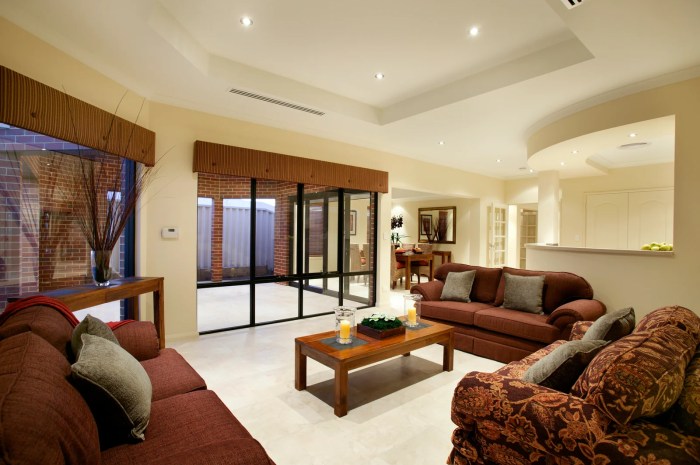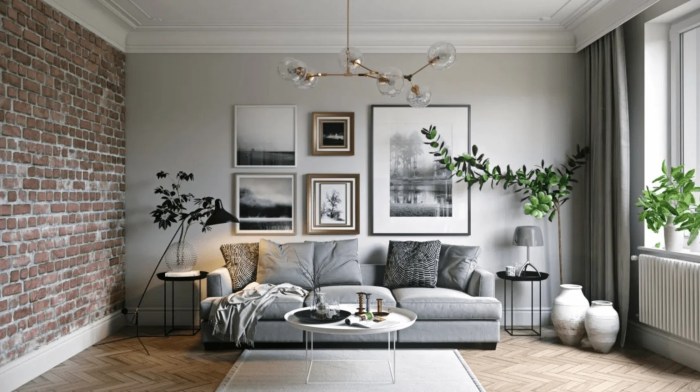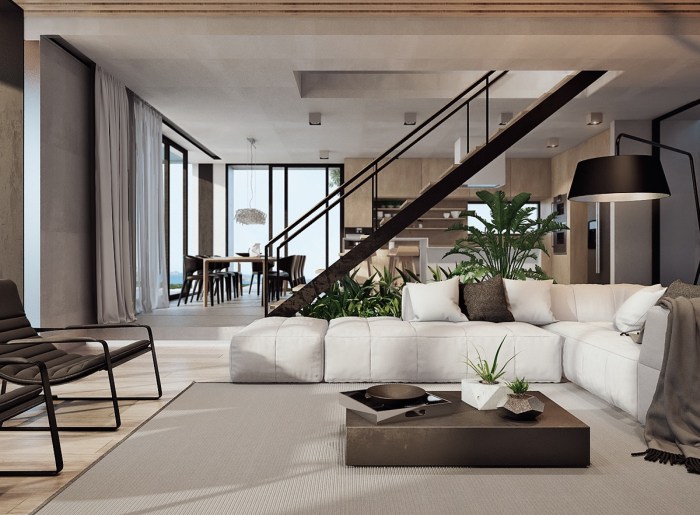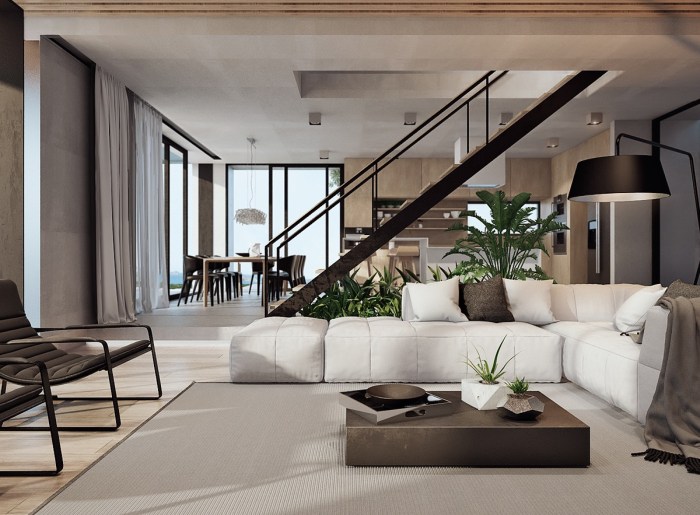Best design interior house is a concept that embodies the perfect blend of functionality, aesthetics, and personal preferences. It’s a harmonious fusion of space planning, lighting, color palettes, and furniture selection, all working together to create a space that is both visually appealing and comfortable to live in.
This journey into the world of interior design will explore the key elements that contribute to a successful design, from understanding different design styles to incorporating sustainable practices.
This guide aims to provide insights into the art and science of creating a well-designed interior space, empowering you to transform your house into a home that truly reflects your personality and lifestyle.
Lighting Design: Best Design Interior House
Lighting is a crucial element in interior design, as it significantly impacts the overall atmosphere, functionality, and aesthetics of a space. It can create a sense of warmth and intimacy, highlight architectural features, and even influence mood and behavior.
Achieving a best design interior house doesn’t solely depend on the size of the space. Even a compact 500 square feet house can be transformed into a stylish and functional home with clever design choices. Explore innovative ideas and inspiring layouts for 500 square feet house interior design to discover how maximizing every inch can create a beautiful and comfortable living environment.
Ultimately, the best design interior house is one that reflects your unique personality and needs, regardless of its size.
Types of Lighting
Different types of lighting serve specific purposes and create distinct effects. Understanding these types is essential for designing a well-balanced lighting plan.
- Ambient Lighting: Provides general illumination for a space. It creates a base level of brightness and helps define the overall mood. Examples include ceiling lights, chandeliers, and pendant lights.
- Task Lighting: Designed for specific activities, such as reading, cooking, or working. It provides focused, directed light to reduce eye strain and improve visibility. Examples include desk lamps, under-cabinet lights, and reading lamps.
- Accent Lighting: Used to highlight specific features or objects, adding depth and visual interest. Examples include spotlights, track lighting, and wall sconces.
Lighting Plan for a Living Room
Here’s a hypothetical lighting plan for a living room, incorporating the different types of lighting discussed:
- Ambient Lighting: A large, central chandelier provides general illumination, creating a warm and inviting atmosphere. It can be dimmed for a more intimate setting.
- Task Lighting: Floor lamps placed near reading chairs provide focused light for reading. A dimmer switch allows for adjustable brightness levels.
- Accent Lighting: Track lighting mounted on the ceiling highlights artwork and sculptures, adding visual interest and showcasing these elements. Recessed lighting in the ceiling can also be used to accentuate architectural features.
Material Selection and Finishes
The choice of materials and finishes plays a pivotal role in shaping the aesthetic appeal, functionality, and overall ambiance of an interior space. From the flooring beneath your feet to the countertop where you prepare meals, each element contributes to the cohesive design narrative.
Flooring Materials
Flooring materials significantly impact the visual character and practicality of a space.
- Hardwood Flooring: Known for its durability, warmth, and natural beauty, hardwood flooring offers a classic and timeless appeal. It comes in various wood species, each with unique grain patterns and color variations. However, hardwood can be susceptible to scratches and dents, and it requires regular maintenance.
- Tile Flooring: Tile flooring provides a durable and versatile option, available in a wide array of materials, colors, and patterns. Ceramic and porcelain tiles are popular choices for their water resistance and ease of cleaning. Natural stone tiles, such as marble and granite, offer luxurious aesthetics but can be more expensive and require specialized care.
- Carpet Flooring: Carpet offers warmth, sound absorption, and a soft feel underfoot. It’s a good choice for bedrooms and living areas, but it can be prone to stains and require regular cleaning.
- Laminate Flooring: Laminate flooring is a cost-effective alternative to hardwood, mimicking the look of wood without the high price tag. It’s durable and easy to maintain, but it lacks the natural warmth and character of real wood.
Countertop Materials
Countertops are a focal point in kitchens and bathrooms, influencing both functionality and style.
The best design interior house is one that maximizes functionality and style within its space. If you’re looking for inspiration on how to achieve this in a smaller footprint, you might find the 40 sqm house design 2 storey interior concept quite intriguing.
This design approach demonstrates that even with limited square footage, you can still create a beautiful and practical living space that feels spacious and inviting.
- Granite Countertops: Granite is a durable and heat-resistant natural stone, offering a luxurious and timeless look. Its unique veining patterns add visual interest and character. However, granite can be porous and require sealing to prevent stains.
- Quartz Countertops: Quartz is an engineered stone, combining natural quartz crystals with resins and pigments. It’s highly durable, non-porous, and stain-resistant, making it a practical choice for busy kitchens. Quartz offers a wide range of colors and patterns, replicating the look of natural stone.
- Marble Countertops: Marble is a classic and elegant natural stone, known for its distinctive veining and soft, luxurious feel. However, marble is porous and susceptible to etching and staining, requiring careful maintenance.
- Laminate Countertops: Laminate countertops are a budget-friendly option, offering a wide range of colors and patterns. They’re durable and easy to clean, but they lack the natural beauty and longevity of stone countertops.
Wall Finishes
Wall finishes create the backdrop for your interior design, influencing the overall ambiance and mood of a space.
- Paint: Paint is a versatile and affordable option for walls, offering endless color possibilities. It’s easy to apply and maintain, allowing for quick updates and changes.
- Wallpaper: Wallpaper adds texture, pattern, and visual interest to walls. It comes in a wide variety of styles, from traditional to modern, allowing you to create a unique and personalized look.
- Wall Tile: Wall tile is a durable and water-resistant option for kitchens, bathrooms, and other areas prone to moisture. It offers a wide range of colors, patterns, and textures, from classic subway tile to intricate mosaics.
- Wood Paneling: Wood paneling adds warmth, texture, and a natural element to walls. It can create a classic and elegant look, or a rustic and cozy ambiance depending on the type of wood and finish used.
Accessorizing and Styling

Accessorizing and styling play a crucial role in completing the design of a space, adding personality and visual interest to a room. These elements can transform a space from basic to breathtaking, reflecting the homeowner’s style and creating a cohesive and inviting atmosphere.
Decorative Elements for Enhancing Visual Appeal
Decorative elements can significantly enhance the visual appeal of a room, adding depth, texture, and personality to the overall design.
- Artwork:Artwork can be a powerful statement piece, setting the tone for the entire room. From abstract paintings to photography, sculptures, and even tapestries, artwork can evoke emotions, create focal points, and add a touch of sophistication. For example, a vibrant abstract painting can inject energy into a minimalist living room, while a calming landscape photograph can create a serene atmosphere in a bedroom.
- Plants:Plants bring life and vibrancy to a space, adding natural elements and creating a sense of tranquility. They can also help purify the air and improve indoor air quality. Consider incorporating different types of plants, from large statement plants like a fiddle leaf fig to smaller succulents and herbs, to add visual interest and texture.
- Textiles:Textiles, such as rugs, throws, and curtains, can add warmth, texture, and color to a space. They can also be used to define different areas within a room or create a sense of intimacy. For example, a plush rug can define a seating area in a living room, while layered throws can add warmth and comfort to a bedroom.
The best design interior house is a reflection of your personal style and taste. From minimalist to maximalist, there are countless options to explore. If you’re looking for a retro vibe, consider incorporating elements of 1960s house interior design , which features bold colors, geometric patterns, and vintage furniture.
This era offers a unique blend of nostalgia and modern appeal, adding a touch of personality to your home.
Contemporary Living Room Mood Board
A contemporary living room mood board can showcase different accessory styles that can be incorporated into this design aesthetic. The mood board might include:
- Sculptural Lighting:Geometric or organic-shaped pendant lights or floor lamps can add a touch of modern elegance to the space.
- Metallic Accents:Gold, silver, or copper accents can add a touch of glamour and sophistication to a contemporary living room. These can be incorporated through decorative objects, furniture, or even artwork.
- Geometric Patterns:Geometric patterns in rugs, pillows, or artwork can add visual interest and a sense of order to the space. These patterns can be bold or subtle, depending on the desired aesthetic.
- Natural Materials:Incorporating natural materials like wood, stone, or leather can bring warmth and texture to a contemporary living room, creating a sense of grounding and balance.
- Minimalist Decor:A contemporary living room often features minimalist decor, with clean lines and a focus on functionality. This can be achieved through simple, geometric shapes and a limited color palette.
Budgeting and Planning

Budgeting and planning are crucial aspects of any interior design project. They ensure that the project stays within financial constraints and that the desired aesthetic and functional goals are achieved. A well-defined budget and plan act as a roadmap, guiding the design process and preventing costly overruns or compromises.
Creating a Realistic Budget
Establishing a realistic budget is essential for successful interior design. It involves understanding the scope of the project, identifying potential costs, and allocating funds accordingly.
- Start by defining the project’s scope, including the areas to be renovated or redesigned, the desired level of finish, and the desired aesthetic.
- Research and gather quotes from contractors, suppliers, and artisans to get an accurate understanding of material and labor costs.
- Break down the budget into categories such as furniture, lighting, flooring, paint, and accessories. Allocate a specific amount to each category based on the project’s priorities and needs.
- Consider unforeseen expenses and include a contingency fund of 10-20% of the total budget to cover potential cost overruns.
Prioritizing Design Elements, Best design interior house
Prioritizing design elements helps ensure that the most important aspects of the project are addressed within the budget.
- Identify the key features that will have the greatest impact on the overall design and functionality of the space. These could include custom cabinetry, statement lighting, or unique flooring materials.
- Allocate a larger portion of the budget to these priority elements while allocating a smaller amount to less critical items.
- Consider using cost-effective solutions for non-essential elements, such as purchasing furniture from secondhand stores or using DIY techniques for accent walls.
Cost-Effective Design Solutions
Maximizing the budget involves finding cost-effective design solutions without compromising on aesthetics or functionality.
- Use a mix of high-end and budget-friendly materials.Incorporate luxurious finishes like marble in small doses, such as on a countertop or backsplash, while using more affordable materials for other areas, like laminate flooring or painted cabinets.
- Shop for furniture and accessories at discount stores or online marketplaces.There are many reputable retailers offering quality furniture and accessories at discounted prices.
- Consider DIY projects.Painting, wallpapering, and simple carpentry projects can save significant costs while adding a personal touch to the space.
- Use natural light to your advantage.Maximize natural light by using large windows, light-colored walls, and mirrors to create a brighter and more spacious feel without relying on expensive lighting fixtures.
- Utilize multi-functional furniture.Choose furniture that serves multiple purposes, such as a sofa bed or a coffee table with storage. This reduces the need for additional pieces, saving both space and money.
Closure

From defining “best” in interior design to incorporating sustainable practices, this exploration has highlighted the multifaceted nature of creating a well-designed home. By understanding the elements of a well-designed house, exploring popular interior design styles, and applying principles of space planning, lighting, color, and furniture selection, you can embark on a journey to transform your living space into a haven of comfort, beauty, and functionality.
Remember, the best design is one that reflects your unique personality and brings joy to your everyday life.
Common Queries
What are some common mistakes to avoid in interior design?
Some common mistakes include neglecting proper lighting, choosing furniture that is too large or small for the space, and ignoring the flow of traffic through the room.
How can I make my small space feel larger?
Use light colors, mirrors, and multi-functional furniture to create the illusion of more space.
What is the best way to incorporate personal style into my interior design?
Start with a mood board to visualize your desired aesthetic. Then, incorporate elements that reflect your personality, hobbies, and interests through art, accessories, and furniture.
How can I create a cohesive design throughout my entire house?
Choose a consistent color palette, use similar materials throughout, and consider how different rooms flow into each other.
